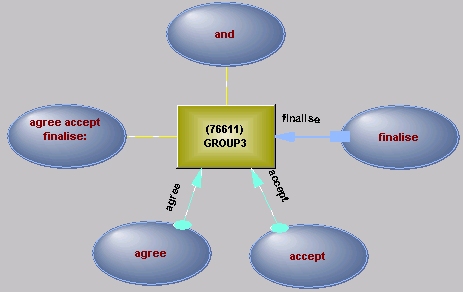
Text often describes several instances:
Jack and Jill went up the hill.
Jack and Jill form an ObjectGroup - a way of combining objects so the combination can be spoken about, while the properties of the elements are also accessible. Any objects, including relations, can form an ObjectGroup.
An ObjectGroup is represented in the network as

with a controlling "And" or "Or" or "And/Or" (the objects here are relations, and GROUP3 is an internal code for ObjectGroup, and nothing to do with three objects in the group).
The "And" here refers to how properties are radiated from the ObjectGroup, not a logical "And". For instance, the weight of A and B is the sum of the weights of A and B, whereas the weight of A or B is a range having as values the weights of A and B.
The head of the ObjectGroup - the node on Pin2 - is the object which is used to refer to the ObjectGroup.
Many sentences have multiple alternatives, as the writer attempts to cover all bases.
All expressed and implied conditions, warranties and other liabilities arising under common law or statute are expressly excluded to the extent permitted by law.
Here there are three object groups
| expressed and implied | |
| conditions, warranties, liabilities | |
| common law or statute |
generating a total of twelve ways of threading the sentence. Even in this simple example, it would be tedious to unwind every possible thread and build structure accordingly. Instead, the different objectgroups become objects with the properties of the objects they contain, so each pathway is open to searching.
The ObjectGroup makes the properties of the objects it groups available, so the ObjectGroup itself can head a relation.
...have been stored, installed, maintained and used...
In this way, expansion of every possibility becomes unnecessary. The type of group (and, or, and/or) determines what properties are available.
All expressed and implied conditions,...
and liabilities arising under common law
Properties asserted before the first object in the group, or after the last object in the group, distribute over the members of the group unless they would cause error, whereas properties declared on individual members within the group do not distribute (the "common" of common law does not distribute over statute - it was caught as a collocation).
ObjectGroups make it much easier to clean up tangled prepositional chains, where a conjunction is embedded in the chain and may refer to any object to its left.
They also make it easier to handle the case where the writer is "tiling the plane" - trying to include every possibility by using many words to describe the same thing. The ObjectGroup then simultaneously emits all the properties of the objects it includes - what was intended.
See